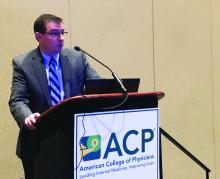PHILADELPHIA – While many internists might think a switch to spironolactone would be warranted for a heart failure patient with inadequate response to oral furosemide (Lasix), transitioning to an alternative loop diuretic may be the preferable approach, a cardiologist said at the annual meeting of the American College of Physicians.
“Lasix is associated with very high variability in terms of absorption, so torsemide and bumetanide should be considered in patients who have a poor response,” said Paul McKie, MD, MPH, a cardiologist and internist with Mayo Clinic, Rochester, Minn., in a session at the meeting.
When polled, only 22% of attendees at the session picked “transition to torsemide” as the best approach for restoring fluid balance with the lowest adverse potential in a 74-year-old woman with nonischemic cardiomyopathy on furosemide 80 mg twice daily who has been hospitalized for fluid overload three times in the year.
The majority of attendees (41%) said they would have added spironolactone. Dr. McKie disagreed with this approach. Instead, Dr. McKie said he would have transitioned this person to an alternative loop diuretic.
he added.
The rationale for considering an alternative loop diuretic in this patient hinges on bioavailability, which is “highly variable” for oral furosemide, at 10%-100%, while by contrast, torsemide and bumetanide have a very consistent bioavailability of 80%-100%, according to Dr. McKie.
“For this reason, I think about using torsemide or bumetanide in patients who are not responding to oral Lasix,” he said.
Dr. McKie described an algorithm that he and his colleagues use in clinic to intensify outpatient therapy for patients not achieving diuresis.
The first step is to ensure adherence and ask patients whether they are following sodium and fluid restriction: “I always ask about that first,” he said. “I tell patients, ‘You can out-eat and out-drink any diuretic regimen.’ ”
The next step is to double the dose of the loop diuretic and, sometimes, triple the dose if the double dose is not effective.
“If they’re diuresing but it’s just not adequate, then I’ll move to twice-daily dosing,” he said. “A practical tip is I tell patients to take their first dose as soon as they wake up and the second dose around 1:00 PM so that they’re not urinating all night.”
If twice-daily dosing doesn’t help, then that’s the point where an alternative loop diuretic would be warranted, according to Dr. McKie’s algorithm.
“Then I add a thiazide like metolazone, but I only do that after I’ve increased the dose of the loop diuretic,” he added.
If all else fails, then outpatient IV diuretics can be considered, according to the algorithmic approach.
Dr. McKie reported no relevant disclosures.

